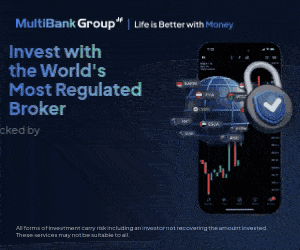Wall Street suffered losses on Friday as tech and growth stocks tumbled following higher-than-expected producer prices for July, causing U.S. bond yields to rise.
The U.S. producer price index (PPI) rose by 0.8% in the 12-month period leading up to July, compared to a 0.2% increase the previous month, driven by rising service costs. Economists had predicted a gain of 0.7%.
While traders generally anticipate that the Federal Reserve will not tighten credit conditions for the rest of the year, the probability of no rate hike in September decreased from 90% to 88.5% after the release of the data.
Following the data, the yield on the 2-year treasury note, which reflects near-term interest rate expectations, rose to 4.9%, putting pressure on rate-sensitive large-cap growth stocks. Tesla, Nvidia, and Apple all experienced losses ranging from 0.4% to 1.8%.
Although the benchmark U.S. indexes saw slight gains in the previous session, concerns regarding the long-term prospects of the U.S. economy and worries about further growth in stocks overshadowed initially positive consumer prices data.
The Dow Jones Industrial Average was down 34.32 points (0.10%), the S&P 500 was down 19.21 points (0.43%), and the Nasdaq Composite was down 101.36 points (0.74%).
The tech-heavy Nasdaq and the S&P 500 are on track for a second consecutive week of losses due to declines in large-cap growth and technology stocks, which have seen significant gains this year.
Of the 11 major S&P 500 sectors, 10 declined on Friday, with tech stocks experiencing the greatest losses, down 0.8%.
Shares of Chinese companies Alibaba and JD.com listed in the U.S. fell 3.0% and 5.4%, respectively, as investors were disappointed by Beijing’s latest stimulus measures and data indicated a slowdown in the country’s post-pandemic recovery.
Declining stocks outnumbered advancing stocks on both NYSE and Nasdaq.
The S&P index recorded one new 52-week high and three new lows, while the Nasdaq had 18 new highs and 82 new lows.
Table of Contents
ToggleHigher Than Expected PPI
- US July PPI exceeds expectations at +0.8% y/y
- PPI for final demand surpasses predictions at +% m/m
- Excluding food and energy, PPI increases by +2.4% y/y and +0.3% m/m
- The release prompts selling in bonds and boosts USD/JPY. US 10-year yields rise by 3 bps to 4.13% and USD/JPY gains around 20 pips.
US July PPI exceeded expectations, indicating increased inflationary pressure.
The final demand for PPI rose more than expected on a monthly basis, while exceeding expectations on a yearly basis.
Excluding food and energy, the PPI also surpassed expectations on both a yearly and monthly basis. Goods, services, and foods all experienced positive monthly growth.
These results have led to selling in bonds and a rise in the USD/JPY exchange rate. Furthermore, the reaction to these figures highlights a heightened concern for inflation.
Upon further analysis, it was found that distribution played a role in driving up prices in the services sector.
EURUSD Fails To Reclaim 1.1000
EUR/USD trades below 1.1000, dragged lower by rising US Dollar demand. The latest data shows an increase in the annual PPI, boosting the Dollar and suppressing the pair.

The resistance level of 1.1020 holds significance, as EUR/USD failed to close above it. If this level becomes support, the pair could target levels of 1.1050, 1.1090/1.1100, and 1.1130.
On the downside, there is support at 1.0980 and 1.0950. A close below 1.0950 could lead to further decline to 1.0920.
EUR/USD reached a two-week high but failed to maintain momentum, closing slightly below 1.1000.
Inflation in the US increased slightly in July, causing a temporary Dollar selloff and pushing EUR/USD higher. However, cautious market sentiment erased the pair’s gains.
European and US stock markets are not providing support for EUR/USD.
USDJPY Retests 145.00
USD/JPY retested 145.00, climbing from 144.50 to 144.82 prior to the release.

Gold Set to Rebound as Inflation Holds Steady
Gold market experienced modest selloff due to inflation numbers. Downward revisions from previous month moderate higher-than-expected July readings.
Spot gold remains virtually unchanged at $1915.03/ounce by the time of this writing, with a slight increase of 0.13% for the day.

Despite some hurdles, the gold price is primed for a confident reversal. While US inflation grew slower than expected, there’s good news for gold investors.
President Biden’s restrictions on new investment in China’s sensitive technologies will drive opportunities for alternative assets like gold.
As the United States Producer Price Index (PPI) accelerates higher, gold faces some selling pressure.
Investors are concerned about sticky inflation and rising rental prices. However, it’s not enough to force the Fed to raise interest rates in September.
Producers have pushed prices up at factory gates beyond forecasts, a positive sign for gold. Gasoline prices have also contributed to the rise in headline PPI. And the core PPI has surpassed expectations as well.
Meanwhile, US inflation has risen steadily, in line with investors’ and the Fed’s expectations. The restricted upside in the US Dollar and the potential for a rate cut in 2024 further fuel the gold price recovery.
Discussions on rate cuts are on the horizon, depending on the state of the inflation economy.
UK Economy Surprises with Modest Growth in Second Quarter
The UK economy exceeded expectations by showing a slight increase in the second quarter of the year. Manufacturing, consumer spending, and government expenditure contributed to the growth, with gross domestic product (GDP) rising by 0.2% compared to the previous quarter. This follows a 0.1% increase in the first quarter.
The drop in raw material prices boosted manufacturing, while the hospitality sector also played a role in keeping the economy afloat. Government spending on public administration, defense, and health further contributed to the positive results.
Consumer spending was a key driver of growth, likely fueled by favorable weather conditions and a surge in live events in June. However, there are concerns about how consumer spending will be affected by less favorable weather in July and August.
The UK government is prioritizing economic growth this year, with a focus on tackling inflation. In an attempt to combat rising prices, the central bank has raised interest rates to their highest level since 2008. However, there are concerns about the potential negative effects of these rate hikes on UK activity and inflation.
Despite the recent growth, the UK economy has not fully recovered to pre-pandemic levels. The Bank of England expects GDP growth to remain below pre-pandemic rates in the medium term, highlighting the ongoing challenges faced by the country.
GBP USD Daily Chart
“The GBP/USD pair stays on the defensive near 1.2680 as the UK GDP reveals positive figures.”

FAQs About Producer Price Index (PPI)
What does PPI stand for in forex trading?
PPI stands for Producer Price Index. It is a measure of the average change over time in the prices received by domestic producers for their output.
How does the Producer Price Index (PPI) measure price changes?
The PPI measures price changes by tracking the prices of a basket of goods and services at various stages of production, starting from raw materials to the final finished products.
What is the significance of PPI data for traders?
PPI data is significant for traders as it provides insights into inflationary pressures within an economy. It helps traders anticipate potential changes in consumer prices and adjust their trading strategies accordingly.
Does an increase in PPI imply rising costs for consumers?
An increase in PPI can imply rising costs for consumers. Higher production costs can be passed on to consumers through increased prices for goods and services.
Why is it important to contain an increase in the general price level?
It is important to contain an increase in the general price level to maintain price stability and prevent the erosion of purchasing power. High inflation can lead to economic instability and negatively impact consumers’ standard of living.
How does increased demand for goods and services affect the economy?
Increased demand for goods and services can stimulate economic growth. It can lead to higher production levels, job creation, and increased consumer spending, which has a positive impact on the economy.
How do central banks combat inflation caused by rising PPI?
Central banks combat inflation caused by rising PPI by implementing monetary policies such as raising interest rates or reducing the money supply. These measures aim to reduce aggregate demand and control inflationary pressures.
Can a rise in PPI lead to higher interest rates?
A rise in PPI can lead to higher interest rates. Central banks may raise interest rates to curb inflationary pressures resulting from increased production costs.
How can increased PPI impact currency rates?
Increased PPI can impact currency rates by influencing market expectations of future interest rate changes. If higher PPI suggests potential inflationary pressures, it may lead to a stronger currency as investors anticipate tighter monetary policy.
How do higher interest rates attract foreign investors?
Higher interest rates can attract foreign investors by offering higher returns on investments. This can increase demand for the currency and strengthen its value.
What is the carry trade strategy in forex trading?
The carry trade strategy involves borrowing money in a low-interest-rate currency and investing it in a high-interest-rate currency to profit from the interest rate differential.
Is there a time lag between PPI and consumer inflation?
There can be a time lag between PPI and consumer inflation. Changes in producer prices may take time to trickle down to consumer prices due to factors such as distribution costs and inventory levels.
Can astute traders forecast the impact of PPI on CPI and interest rates?
Astute traders can analyze historical correlations and economic indicators to make informed predictions about the impact of PPI on consumer price inflation (CPI) and interest rates. However, forecasting is subject to uncertainties and market dynamics.
What is the signaling effect of PPI data in the market?
PPI data can serve as a signaling tool for market participants. A higher-than-expected PPI reading can indicate potential inflationary pressures, influencing market sentiment and guiding investment decisions.
Where can I find forex news and technical analysis?
You can find forex news and technical analysis on various financial websites, news portals, and dedicated forex trading platforms.
What are the risks associated with leveraged trading in foreign currency?
Leveraged trading in foreign currency carries inherent risks, including potential losses exceeding the initial investment. Traders should be aware of market volatility, liquidity risks, and the impact of leverage amplifying both profits and losses.
Can TraderFactor.com provide educational resources for beginners in forex trading?
Yes, TraderFactor provides educational resources for beginners in forex trading. We offer articles, tutorials, webinars, and other learning materials to help individuals understand the basics of forex trading and develop their skills.
Is investing in forex suitable for all investors?
Investing in forex involves substantial risks and requires a good understanding of the market dynamics, risk management strategies, and financial knowledge.
How Does The PPI Impact Currencies
The Price Index (PPI) can have an impact on currencies, including the EURUSD pair. Here are a few examples:
Increased PPI leads to higher inflation expectations
If the PPI for a country, such as the Eurozone, rises more than expected, it may signal potential inflationary pressures. This can lead to an increase in interest rates by the central bank, attracting foreign investors seeking higher returns. As a result, the demand for the currency, such as the Euro (EUR), may strengthen against other currencies like the US Dollar (USD).
Lower PPI reduces inflationary pressures
On the other hand, if the PPI is lower than anticipated, it may indicate reduced inflationary pressures. This could lead to lower interest rates or accommodative monetary policy. As a result, the currency’s value, such as the Euro (EUR), may weaken against currencies like the US Dollar (USD).
Market sentiment and risk appetite
PPI data can also influence market sentiment and risk appetite. For example, if higher-than-expected PPI data suggests potential inflationary pressures, it could increase market expectations of tighter monetary policy. This may attract investors to currencies with higher interest rates, potentially strengthening them against currencies with lower interest rates.
It’s important to note that currency movements are influenced by various factors, and PPI is just one of many economic indicators that traders consider when analyzing currency pairs like EURUSD. Additionally, the impact of PPI on currencies can vary depending on market conditions and other fundamental factors.
How can a trader prepare For PPI figures release
To prepare for the release of Producer Price Index (PPI) figures, traders can follow these steps:
- Check the economic calendar or financial news sources to know the exact date and time when the PPI figures will be released. This information is crucial for planning your trading strategy accordingly.
- Monitor market consensus and analyst forecasts regarding the upcoming PPI figures. This will help you understand the anticipated impact on the market and gauge whether the actual figures are likely to meet, exceed, or fall short of expectations.
- Understand the relationship between PPI figures and currency movements. Consider the historical correlation and any recent trends. Determine whether a higher or lower-than-expected PPI figure is likely to strengthen or weaken the respective currency.
- Take into account other relevant economic indicators that could interact with the PPI data. For example, consider how inflation, interest rates, or central bank policy might come into play.
- Determine your risk tolerance and establish appropriate risk management measures such as stop-loss orders or position sizing. Volatility often accompanies major economic releases like the PPI figures, so it’s essential to protect your trading positions.
- Plan for different outcomes based on varying PPI figures. Create multiple trading strategies that cater to different possibilities, such as if the actual figures match expectations, exceed them significantly, or disappoint.
- Once the PPI figures are released, closely monitor the market reaction. Watch for immediate changes in currency pairs, assess the overall sentiment, and take advantage of potential trading opportunities that arise.
Read These Next;
Exploring Forex Factory: An Invaluable Resource for Traders
The Best Time to Trade Forex: Maximizing Profit Potential
The Winning Mindset for Weekend Forex Trading
Essential Education for Taxes on Forex Trading
What is a Margin Level in Forex?
Forex Breakout Strategy: A Guide for Profitable Trading
Forex Consolidation Breakout Strategies for Traders
Master Forex Flag Pattern Strategy for Profit
Disclaimer:
All information has been prepared by TraderFactor or partners. The information does not contain a record of TraderFactor or partner’s prices or an offer of or solicitation for a transaction in any financial instrument. No representation or warranty is given as to the accuracy or completeness of this information. Any material provided does not have regard to the specific investment objective and financial situation of any person who may read it. Past performance is not a reliable indicator of future performance.

















